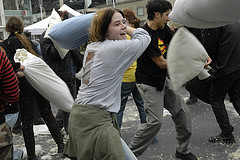
I’ve just returned from a week-long trip to Cartagena, Colombia. The occasion was Kathryn’s brother’s wedding, and it was a beautiful visit. We stayed at a resort facing the Carribean, and it was mostly a resort-centred week: bodysurfing in the ocean, swimming in the pools, and enjoying unlimited piña coladas. The wedding itself was lovely, and a great chance to meet Kathryn’s extended family.
Cartagena itself was a surprise to me. My only prior visit to Latin America was a daytrip to Tijuana, and I knew the poverty there was a side-effect of its border location. Cartagena seemed fairly prosperous, but perhaps they keep it looking nice for the large tourist industry. It had a lovely old town, with a very European feel: pedestrian streets, squares with cafes and restaurants, and old cathedrals. The new town was bustling and modern, and the little beach-focused neighbourhoods seemed quiet and easygoing. Overall, the place felt like it would fit in on the European side of the Mediterranean: bits of Marseille, bits of the sleepy beach towns on the Adriatic coast of Italy, bits of the Costa del Sol in Spain. Mind you, there was a strong police and military presence around to achieve this feel: police everywhere, machine-gun toting guards here and there, and even a camouflaged chopper overhead at one point. That didn’t really interfere with the experience too much, though.
And of course it was nice and hot: a comfortable 30 degrees every day, and warm nights. I managed to avoid a sunburn, but I got a wide variety of jellyfish stings crisscrossing my body during a snorkelling daytrip. It was great to visit a reef again, for the first time since my visit to Lady Elliott Island in the Great Barrier Reef at the age of seven. The reef was deeper than I expected: you had to dive a good 3 to 4 meters down to reach the coral and fish. In some ways, that made it more rewarding, since you had to really work at it to get a good view of the brilliant colours.
The buffet served weird and tasty fruits: lulo, pitaya, mora and the tangy tamarillo (tree tomato). Oranges were green, limes and plantains were popular, but lemons and bananas weren’t around anywhere. Confused yet?
I’d highly recommend coastal Colombia to North Americans. It seems to be quite popular with Latin American tourists, but there were few white faces around – probably scared off by press coverage of the country.


